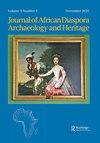African Diaspora Foodways in Social and Cultural Context
Q1 Arts and Humanities
Journal of African Diaspora Archaeology and Heritage
Pub Date : 2020-05-03
DOI:10.1080/21619441.2021.1928960
引用次数: 3
Abstract
African diaspora foodways stand at a crossroads between necessity and expression, biology and culture, sustenance and pleasure. Eating is a biological imperative. But foods are also deeply imbued with cultural meaning. Enslaved African and African American cooks in the Americas created meals that reflected their varied African homelands as well as European and Native American influences. Indeed, Peggy Brunache (2011, 180–182) has argued that this culinary creolization began before enslaved people reached the New World; captives were provided a mixture of culturally familiar and unfamiliar provisions on ships, including American-grown crops like maize. Even under the extreme and deprived conditions of the Middle Passage, newly enslaved people exercised some agency in relation to their food consumption—for example, a first-hand observer in the 1700s reported that captives sometimes refused to eat broad beans, instead tossing them overboard (Brunache 2011, 183). From the beginning, then, the foods of African descendant people in the Americas were profoundly embedded in broader social systems of control and resistance. As Alexandra Crowder (2021) explains, a forced and abrupt change in diet for enslaved captives newly arrived in the Americas was both culturally disorienting and dehumanizing. Indeed, it was designed to be so. Food played a continuing role in social control on plantations as well; the enslaved relied on their enslavers for either direct provisions, an allotment of time to grow their own food, or some mixture of both. These provisions of food and time, of course, could be withheld. As much as food remained a tool of social control on the part of slave owners, for enslaved people, it was also a means of resistance to that control. In a recent study of provisioning at Jesuit haciendas in Peru, Brendan Weaver, Lizette Muñoz, and Karen Durand (2019, 1016) observed that “Foodways among the enslaved populations ... stand at the intersection of top-down and bottom-up processes at the estates.” Brunache argued a similar point when she identified the社会和文化背景下的非洲侨民饮食方式
非洲侨民的饮食方式处于需求与表达、生物与文化、维持与愉悦之间的十字路口。吃是一种生理上的需要。但食物也深深浸透着文化意义。在美洲,被奴役的非洲人和非裔美国人的厨师创造的食物反映了他们不同的非洲家园以及欧洲和美洲原住民的影响。事实上,Peggy Brunache(2011, 180-182)认为,这种烹饪的克里奥尔化在奴隶到达新大陆之前就开始了;船上提供给俘虏的食物既有熟悉的文化,也有不熟悉的文化,包括玉米等美国种植的作物。即使在中间通道极端和贫困的条件下,新被奴役的人在食物消费方面也行使了一些代理——例如,18世纪的一位第一手观察者报告说,俘虏有时拒绝吃蚕豆,而是把它们扔到海里(Brunache 2011, 183)。因此,从一开始,生活在美洲的非洲人后裔的食物就深深植根于控制和抵抗的更广泛的社会体系中。正如亚历山德拉·克劳德(Alexandra Crowder, 2021)所解释的那样,对刚抵达美洲的被奴役俘虏来说,强迫和突然的饮食变化既使他们在文化上迷失方向,又使他们失去人性。事实上,它就是这样设计的。食物在种植园的社会控制中也扮演着持续的角色;被奴役的人要么依靠他们的奴隶主直接供应,要么依靠他们分配的时间来种植自己的食物,要么两者兼而有之。当然,这些食物和时间是可以不提供的。就像食物一直是奴隶主控制社会的工具一样,对被奴役的人来说,它也是反抗这种控制的手段。在最近一项关于秘鲁耶稣会庄园供应的研究中,Brendan Weaver, Lizette Muñoz和Karen Durand(2019年,2016年)观察到“被奴役人口的食物方式……站在自上而下和自下而上流程的交汇处。”Brunache在鉴定出
本文章由计算机程序翻译,如有差异,请以英文原文为准。
求助全文
约1分钟内获得全文
求助全文
来源期刊

Journal of African Diaspora Archaeology and Heritage
Arts and Humanities-History
CiteScore
0.80
自引率
0.00%
发文量
9
期刊介绍:
Journal of African Diaspora Archaeology and Heritage provides a focal point for peer-reviewed publications in interdisciplinary studies in archaeology, history, material culture, and heritage dynamics concerning African descendant populations and cultures across the globe. The Journal invites articles on broad topics, including the historical processes of culture, economics, gender, power, and racialization operating within and upon African descendant communities. We seek to engage scholarly, professional, and community perspectives on the social dynamics and historical legacies of African descendant cultures and communities worldwide. The Journal publishes research articles and essays that review developments in these interdisciplinary fields.
 求助内容:
求助内容: 应助结果提醒方式:
应助结果提醒方式:


